Two months from today, voters in Oregon’s second-largest county will decide who will have their fingers on the region’s biggest sprawl button.
Though Washington County, which sits on the western third of the Portland metro area, isn’t facing the rocketing housing demand it once was, its political conversation continues to be dominated by issues of land use, real estate development and transportation — and its five-member board is essentially split 3-2 in favor of expanding urban growth boundaries.
Three of those seats, though, are up for grabs, and a trio of candidates — two challengers, one incumbent — are hoping to tip the county’s balance against suburban expansion. Candidates in two of those races faced off at an event covered by the Oregonian Wednesday night.
County Chair Andy Duyck said that the central question of the campaign is whether the county has enough room in its urban areas to continue developing single-family homes.
He thinks urban boundaries should expand so the county can do so.
“In about 15 to 20 years, there will be no new single-family homes being built in this region,” said Duyck. “There are some people that don’t want you to have a choice. I think that’s what this election is really all about.”
Duyck is facing Allen Amabisca, an Intel employee and neighborhood activist from Helvetia, which would have been affected by a Duyck-backed plan to urbanize that area that was recently scotched by the state Court of Appeals. Here’s a passage from an Amabisica campaign email circulated Thursday:
The other week as I was driving to the office, I saw school children walking to school on the side of the road in a ditch, because there was no sidewalk. At the same time there were thousands of school children in morning rush hour with their parents on their way to school because parents are concerned about the safety of their children when walking to school.
Having good educational outcomes means having students that are safe, well-rested, and focused. When it comes to how we spend your tax dollars, I will prioritize our roads and sidewalks over tax breaks for special interests.
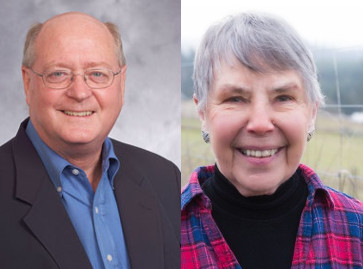
challenger Elizabeth Furse.
(Photos from campaign websites)
Meanwhile, in the race to represent Washington County’s huge western district, including Hillsboro and Forest Grove, former U.S. Congresswoman Elizabeth Furse is carrying a “smart growth” banner against incumbent Bob Terry.
“When I came to Washington County, I loved the fact that you can be in a city and then right away be in the country,” Furse said at Wednesday’s forum. “And that’s what I want to preserve. … Once land is paved over, you can’t farm it.”
Terry, for his part, says on his website that “you are not going to find half the population of Washington County commuting on mass transit and bicycles.”
It’s a theme he hit in his last campaign, in 2010. In fact, Terry doesn’t seem to have updated his campaign website’s policy statement on population growth issues at all in the last four years.
“It in the last 10 years we have grown in population by just over 20%,” his website says, just as it did in 2010. “If current trends continue, we will soon catch and pass Multnomah County.”
But as every American knows, current trends didn’t continue, and Terry’s statistic is no longer accurate: Washington County’s 10-year growth rate is down to 16 percent and falling fast.
Whether Washington County voters have updated their perspective on Terry in the last four years remains to be seen. Ballots will go out May 2, and election day is May 20.



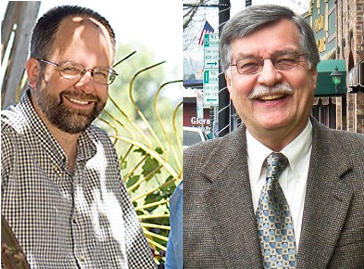
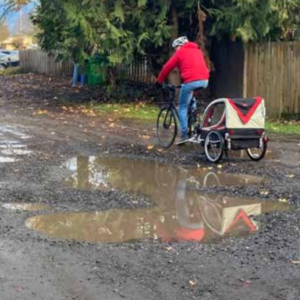
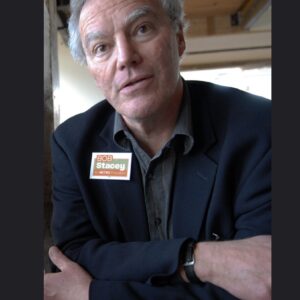
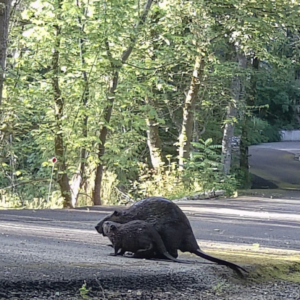
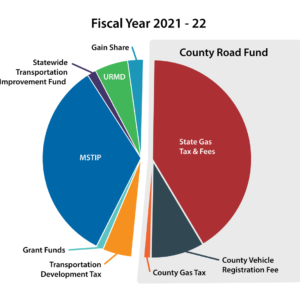
Thanks for reading.
BikePortland has served this community with independent community journalism since 2005. We rely on subscriptions from readers like you to survive. Your financial support is vital in keeping this valuable resource alive and well.
Please subscribe today to strengthen and expand our work.
“…County Chair Andy Duyck said that the central question of the campaign is whether the county has enough room in its urban areas to continue developing single-family homes. He thinks urban boundaries should expand so the county can do so.
“In about 15 to 20 years, there will be no new single-family homes being built in this region,” said Duyck. “There are some people that don’t want you to have a choice. I think that’s what this election is really all about.” …” andersen/bikeportland?
Mr Duyck thinks that people having a choice to live in a single-family home, is what this election is really about. I’ll try keep that in mind next time I’m stuck trying to make my way through the nightmare traffic congestion of roads like 185th, Cornell Rd, Murray Rd, Scholl’s Ferry Rd, or maybe even Bethany Blvd, to name a few. The misery of that experience for people traveling those roads, some of them living along them, must be worth it, if it means they have the choice to live in a single-family dwelling.
If the single-family home choice is the central issue Duyck thinks this election is about, I wonder, if he thinks there are some, what he may think are some of the secondary issues this election may be about. Maybe at a later date, he’ll share some ideas with bikeportland, about what those issues are.
As the urban growth boundary is expanded, the countryside goes further and further away. Various forces in the county continue to strongly support planning strategies that locate housing, employment, and goods and services centers miles away from each other, much further than most people would care to get between them by means other than a motor vehicle. This kind of planning results in noisy, filthy congestion, increasingly rising to levels that people don’t seem to like very well.
There may be fair numbers of people in the county that consider the election to really be about far more pressing issues than whether everyone has a choice to live in a single-family dwelling.
Follow the cash. Look who’s behind Andy “Single Family Homes” Duyck. Yup, home builders.
It’s a deliberate error to equate a slow down in building single-family homes with having no choice. There are hundreds of thousands of single-family homes in Washington County already – available for those who choose them. No one is tearing them down in large numbers.
What we’re seeing all over America is a shift in demand — more and more people are living lifestyles that prefer attached housing, apartments, co-housing, etc. As the community ages and chooses to drive less, we’ll have more and more people who don’t want a huge lawn to deal with, and would rather have an apartment in a walkable neighborhood.
We’re all subject to our own narrow-casting of what people like. Folks who live in single-family homes often think everyone wants to be like them; people who have elderly parents or younger friends without kids know the beauty of other options.
We need a diversity of housing stock to serve the diversity of demand, and that’s what we’re moving towards, if we elect forward-looking Washington County Commissioners.
So true. Washington County has a huge supply of single-family residential housing. I think it is choices other than single family residential that Duyck’s transportation and land-use policies will limit. Demographic and cultural changes coupled with rising energy costs are driving increasing numbers people to choose neighborhoods that Duyck isn’t preparing Washington County for.
Re: the need for single family homes, Chairman Duyck received $37,625 from Citizens for Good Government, a PAC whose treasurer was Tom Brian, former Washington County Chair and now a land development consultant. The contribution on December 20, 2012 before Chairman Duyck had an opponent. According to the Secretary of State’s Office, contributors to the PAC and their contributions beginning on December 2, 2012 were the following:
Arbor Custom Homes 1165
RES Construction Company 10000
Northwest Earthmovers, Inc. 10000
Garner Electric 2500
A-1 Security Metal Fab, Inc. 600
Muehe Quality Heating, Inc 500
OTAK, Inc. 5000
Leonard Adams Insurance, Inc. 500
Lakeside Industries 300
Great NW Gutters, LLC 500
Hollabaugh Brothers & Associates 500
Trademark Landscapes, Inc. 2500
Timber Tech Framing LLC 7500
Ariel Truss Company Inc 500
Fireside Contracting Services, LLC 500
Myhre Group Architects, Inc. 1500
Bliss Roofing, Inc. 700
GeoPacific Engineering, Inc. 1000
Westside Drywall, Inc. 3500
Fettig Commercial Construction,Inc 2500
CNA LLC 1200
Northwest Community Mgmt. Co. 250
Cromwell Plumbing, Inc 3500
Dolan Northwest LLC 700
Parker Concrete, Inc 4500
Froelich Consulting Engineers 500
Brown, Rask, Sweeney et al, LLP 500
Affordable Window Coverings 500
Ultra Quiet Floors 500
Kittelson & Associates, Inc 500
Gary’s Vacuflo, Inc. 500
Northwest Commercial Exterior Co. 1000
Parr Lumber 1000
Wolcott Plumbing 2000
First Response Systems, Inc. 500
Pacific Crest Building Supply 2500
Clean it up MARK! 500
G.W. Paulson Co. 4000
From the full statement on the page of his website, Bob Terry’s view on county residents’ use of mass transit and bikes for commuting, would seem to be considerably broader than the following single excerpt from that page that is used in the above bikeportland story:
“…Terry, for his part, says on his website that “you are not going to find half the population of Washington County commuting on mass transit and bicycles.”…” andersen/bikeportland
It’s important to read the full statement. I don’t want to copy and paste the whole thing in this comment, so again, here’s the link to that page:
https://web.archive.org/web/20101026104542/http://www.bobterryforcountycommissioner.com/issues/growth.html
With the exception of his use on that page, of the phrase ‘Utopian Paradise’, I’d be inclined to have considerable confidence in Terry’s claim about importance he places on a “…balanced approach toward its inevitable growth.” Said as he has, I have to be very skeptical that he’s committed to a balanced plan approach for growth that include at least some provision for people interested in commuting to work by bike.
Currently, all the county has for bike to work commuting, are side of the road bike lanes, which many people simply will not use because of reservations they have about riding directly alongside motor vehicles. The county should be at least, be studying and making plans for a core, basic cycle track system linking key population centers, such as Beaverton, Hillsboro, Aloha. Such a system could help to alleviate some of the downside of inevitable motor vehicle use congestion brought about by the inevitable growth he acknowledges will likely occur.
Our west side seems content with having everything really far apart, and then trying to compensate with wider roads and overly high speed limits. And I think the people in cars don’t really see a problem with that.
Unfortunately my copy concerning the PAC contributions posted before I could finally edit it. The period in which contributions were collected were in 2013, not in 2012. The check for the contribution was dated December 20, 2013.
I’m going to be one of those “not in my back yard” commentors. We purchased our home just off the Brookwood area because if I go East I have everything I need within walking or biking distance for the most part, and if I go West, I am in the “boonies” in a matter of minutes. I fully admit this was a huge draw to a home in that location and I don’t want further development to the west/north (Helvetia) area.
Thanks for the insights wsbob. Although I enjoy living in a single-family house, as do most families with kids who can afford to, I think it’s important to recognize that the “choice” language is really window dressing for the homebuilders’ agenda, something which I do NOT implicitly support. As Evan pointed out, there are still plenty of single-family homes on the westside, and always will be.
I do think we need to tilt the balance towards more density with amenities closer together, with less dependence on massive 45+mph super-arterials that people don’t want to walk or bike along. Compared to most American metro areas our westside suburbs have smaller lots, but the builders are still putting up monstrous homes that fill up most of the lot, claiming that’s what buyers want — while I hear complaints from those same buyers whom I work with that they don’t have enough yard.
That’s partly (some of) the buyers’ fault, but I think blaming “the market” is a cop-out, and we need to push back more. In addition to putting up smaller, more affordable (and – ahem – less profitable) homes on the lots they are currently building on, more emphasis on density might also allow for low-maintenance freestanding homes on even smaller lots that don’t really even exist out here at the moment, and a wider variety of affordable multi-unit housing. Q: Why is it that townhomes and condos end up costing just as much as freestanding homes, when they clearly take up less space and are cheaper to build? A: Not enough supply!
It was about 20 years ago when I was living in Seattle, and stuck in traffic in the suburban mess of Renton where I worked, that the light bulb went off in my head: it finally dawned on me that in many American metro areas, congestion is actually worse in suburbs than it is in cities. Maybe not quite in terms of miles per hour (though sometimes that is also true), but certainly in terms of destinations per hour. To this day I do not think most suburbanites have figured that out. To its credit Beaverton, at least, has done more than the typical ‘burb in building half-decent bike facilities, but they’re still underutilized because there’s a long way yet to go in terms of nearby development patterns that encourage people to actually use them.